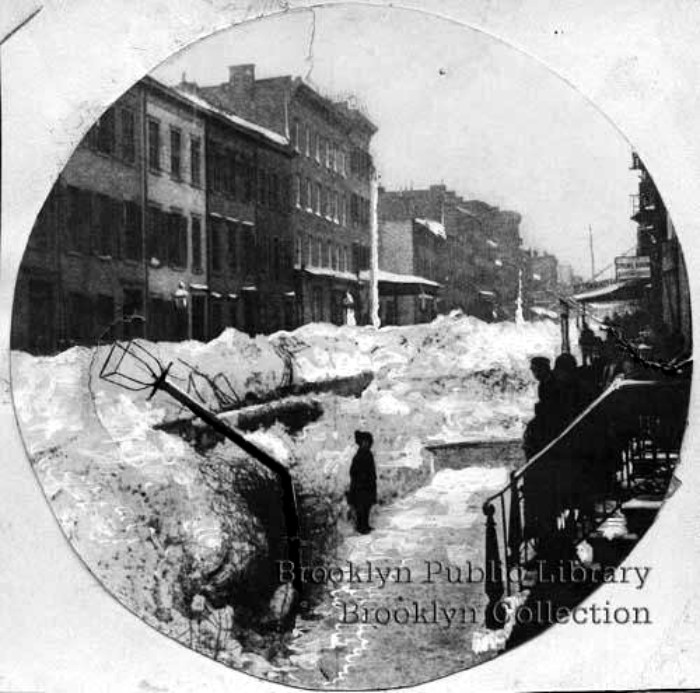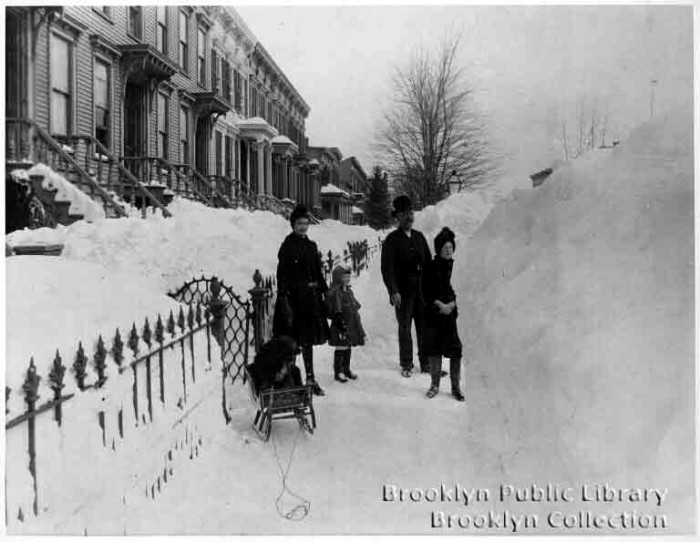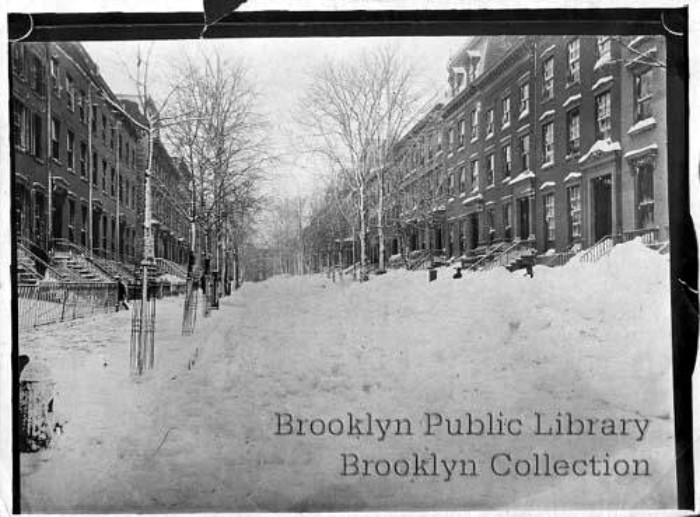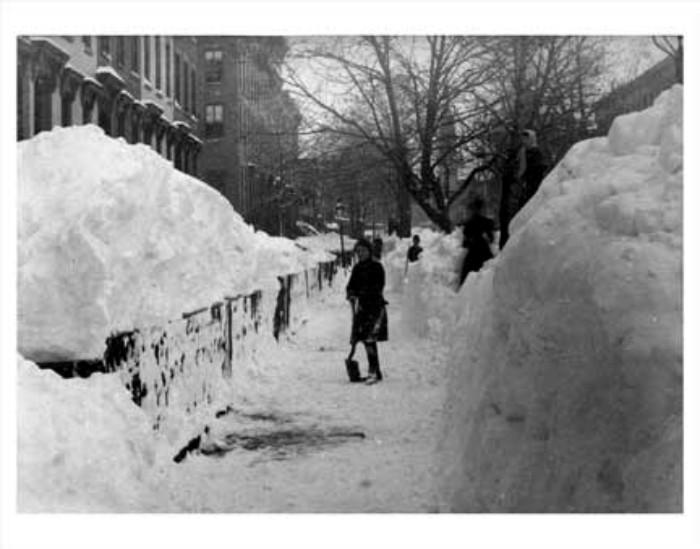Walkabout: The Snowpocalypse of 1888
The advent of a potential blizzard causes me to pause my story of the Musica family. They’ll be back on Thursday. Meanwhile, please consider the following: Whenever anyone talks about snowstorms in New York City, the Great Blizzard of 1888 is always mentioned. The photographs of Victorian era folk standing next to eight foot snowdrifts…


The advent of a potential blizzard causes me to pause my story of the Musica family. They’ll be back on Thursday. Meanwhile, please consider the following:
Whenever anyone talks about snowstorms in New York City, the Great Blizzard of 1888 is always mentioned. The photographs of Victorian era folk standing next to eight foot snowdrifts are iconic pieces of New York City history. We’ve had snowstorms that have dumped more snow down on us in a single storm than that one did, we’ve had plenty that managed to shut down the city, several of them in the last ten or so years. But the storm of 1888 remains legendary. It was known as the Storm of the Century, the Great White Hurricane, and it brought not only huge piles of snow, but also death, destruction, property damage, and propelled the cities of the East Coast into the modern age.
The storm caused so much damage because of the amounts of snow and the heavy winds that blew it into tall mountains that covered everything. It was a classic Nor’easter that roared ferociously up the coast and vented its fury on Washington, Philadelphia, New York, and on up into Boston, the rest of New England and beyond, catching every town and city on its northeastern path to Canada. These were the days before Doppler radar, storm tracking equipment and 24/7 weather alerts. It was also not a typical winter storm. Winter was almost over, you see, and the people in the Mid-Atlantic States were getting ready for the arrival of spring. After all, it was March 12th, 1888.
The weather that early March had been unusually warm, and heavy rains were being welcomed as harbingers of an early spring. It began raining heavily on March 11th, and then, as the day wore on, the temperature began to drop rapidly, and the rain turned into wet, heavy snow. On March 12th, the Brooklyn Eagle newspaper wrote that the snow was, they supposed, officially a blizzard, although it was such a weak affair that people in the Midwest, where they knew what snow was, would regard this little storm as an annoyance.
The snow was falling steadily, but it was beautiful on that day, causing the newspaper writer to quote Emerson, “Announced by all the trumpets of the sky, Arrives the snow, and driving o’er the fields, Seems nowhere to alight.” The paper noted that the milkman’s horse was walking carefully, picking its way through the snow, but the milkman was slipping and sliding, tumbling towards his deliveries “like a strong swimmer plunging into the ocean surf.”
The next day, however, the poetry was gone. The storm raged on with snow falling steadily with no end in sight. It snowed continuously for a day and a half. That was bad enough, but the heavy winds that accompanied the Nor’easter clocked in with sustaining winds of 45 mph, and gusts measured in places up to 54 mph. These winds swirled the snow around, creating drifts 30 to 40 feet in height, covering two and three story buildings. The tallest drift in all of New York City was measured in Gravesend, Brooklyn. It was 52 feet high.
The highest amount of fallen snow was measured in Saratoga Springs, NY. They got 58 inches of snow, just shy of six feet. Albany got 48 inches, New Haven, Ct. got 45 inches, and New York City got 22 inches of snowfall. In contrast, the Blizzard of 2006, which I remember well, had the highest amount of snowfall in New York City history – 26.9 inches of wet packed snow. That storm shut the city down for days. But it was much worse in 1888.
The Brooklyn Eagle wrote on March 13th, “the storm shows how complete is the conquest of human enterprise by the forces of nature.” Everything was covered in tons of snow. In addition to the snow and the winds, and the drifts, the temperature had also dropped, and it was cold out there. Almost everyone’s home was buried in snow. As the city began to dig out, the dangerous part of the storm became clear.
This was 1888, so snow removal was mostly a job for manual labor. There were no plows attached to sanitation trucks trying to cut their way through the streets. They had to be dug out by hand. It was imperative to dig out as soon as possible. Because the storm had been so sudden, many families were without food or fuel. The cold and wind killed untold numbers of livestock and farm animals up the coast. Medical attention was hindered by the inability of doctors or patients to get around, and the freezing temperatures and high winds had snapped hundreds of overhead telegraph and telephone lines, cutting the affected cities off from themselves and the rest of the world.
The main task was to clear the streets so the authorities, emergency workers and food and coal deliveries could get around. The wires needed to be fixed as soon as possible, and people dug out of snow covered dwellings. Over 400 deaths were reported in the affected areas, with 200 of them in New York City alone. Two hundred ships had been grounded by the storm, all up and down the coast between Chesapeake Bay and the eastern provinces of Canada. Over one hundred seamen died because of the storm.
Fires were a huge hazard in New York City. Fire engines and men couldn’t be dispatched, and by the end of the crisis, over $25 million in property damage was incurred. When the snow finally began to melt, and when thousands of wagonloads of snow were pushed into the waters surrounding the city, another problem surfaced – flooding, especially in the low-lying portions of Brooklyn, the parts that still flood today.
The Great Blizzard of 1888 was a hard and bitter lesson in the power of nature and the need for modern solutions to the problems of city living. The legacy of the storm is still with us today. We can thank the Blizzard of ‘88 for forcing Manhattan and most of the rest of the city to bury its utility lines. They had been debating doing that anyway, as the forest of poles and lines was blocking out the sun on many streets, but the Blizzard was a game-changer. There was little argument from budget people or naysayers after the storm.
The storm also convinced the city fathers for the need of underground trains – the subways. They didn’t have to ask Boston twice, within a couple of years of the storm, they had plans on the table, and nine years later, the first underground subway system in the country rolled under that city. New York had a large system of elevated train lines, but the el was stopped in its tracks, literally, by the storm.
The heavy wind gusts threatened to topple trains from their tracks, and the system was put away for the duration. Afterwards, the plans to build the IRT branch of the subway system were dusted off and examined with great interest. The first train debuted in 1904, thirty years after its first elevated train, and sixteen years after the Great Blizzard.
Of course, it wasn’t all horrible. Nature had covered the city in a mountain of snow. School was impossible, and children from every borough and walk of life went outside and played, if only for a while before being sent shopping, or finding work clearing snow or running errands. Amateur and professional photographers went outside and captured some of the best known photographs in the city’s history. A lot of poor men and boys also found work shoveling snow, thereby feeding their families.
And of course, people came together in a time of mutual need. The papers told of neighbors helping neighbors, of groups of people banding together to trek to wherever they could buy food and other necessities for themselves and neighbors. They shoveled snow, cleared snow drifts from windows, and freed people trapped in their homes. People took others in, and the best of humanity showed itself in acts of kindness and charity.
Slowly, after March 14th, the city began digging out and returning to normal. It would take a long time. The New York Stock Exchange had to close for two days, during which time millions of dollars were lost in trades. Factories and businesses had also lost days. Theaters were empty, as were restaurants and shops, many of which could not open for weeks. People who were without food or fuel shivered until they could get relief.
The Brooklyn Eagle summed it up thusly, “Facts like these bring home to us how supreme is our dependence upon each other. Civilized society is so interlinked in all its parts…It [the storm] came like a providential monitor to remind us, in the midst of our selfish warfare and the avaricious devices with which our intercourse abounds, that we cannot get along without each other, and that the noblest and most philosophical of any man or community is in the achievement of the greatest good of all.”
If Tuesday, January 28, turns out to be one of those blizzards to remember, we have the example of the past to guide us. Be prepared, be safe, have fun, take some great pictures, and help your neighbor if you can.
(Blizzard of 1888, Brooklyn Heights. Photograph:Brooklyn Public Library)













You can already see the early signs of gentrification.
Great piece and photos. Thanks for putting it all in perspective.